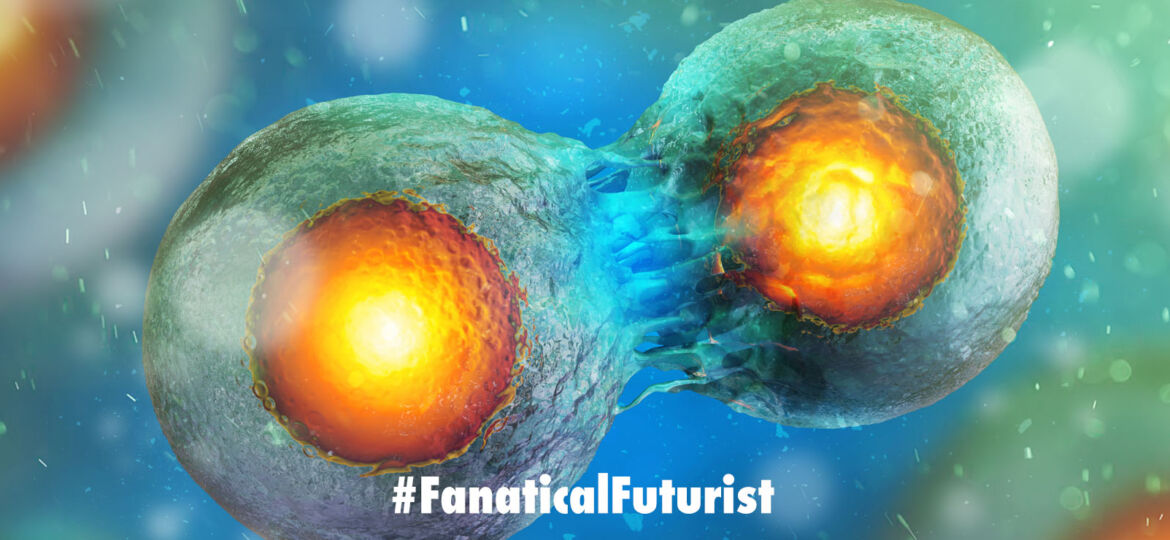
WHY THIS MATTERS IN BRIEF
As our grasp of synthetic biology improves we’re nearing the point where we can create completely synthetic, unnatural cells not found anywhere in nature, and get them to replicate.
 Interested in the Exponential Future? Connect, download a free E-Book, watch a keynote, or browse my blog.
Interested in the Exponential Future? Connect, download a free E-Book, watch a keynote, or browse my blog.
It’s one thing for scientists to develop semi-synthetic and fully synthetic cells made from inorganic and organic components and 4, 6 or even 8 base pair synthetic DNA based organisms that have no equal in nature, and that one day could be used to transform everything from sensor systems to healthcare, and act as the basis of new bio-manufacturing technologies or be used to manufacture revolutionary synthetic proteins, but once they’ve been made trying to get them to divide and replicate in order to not just survive but thrive is an entirely different problem to solve.
Now though researchers at TU Delft in the Netherlands have succeeded in replicating a biological mechanism that is essential for cell division in bacteria in the lab. The research is an important step within a larger project with the ultimate goal of creating a fully artificial cell that can sustain and divide itself. The researchers have published their findings in Nature Communications.
Even in relatively simple bacterial cells, division is a highly complex process. First, the bacterial DNA has to be copied. Next, proteins, the workhorses of the cell, transport copies of the DNA to the two poles of the cell. Then, in the middle of the cell, a ring is formed that consists of specialised proteins. When the cell is ready to divide, this so-called Z-ring squeezes together, creating two identical daughter cells, and voila the cell has divided in two.
The proteins that form the Z-ring in most bacteria always do so neatly in the middle of the cell. But how do they know where the middle is? For this, the cell uses other proteins, three in total and these include MinC, MinD and MinE. Together, they form what’s known as the “Min system.” The MinD protein likes to attach itself to the inner cell membrane. The function of the MinE protein is to drive MinD away. And the MinC protein? It is a passenger that hitches a ride with the MinD and MinE proteins.
The interplay between these three proteins can be described as a game of tag, in which MinE proteins dislodge MinD from the membrane. Chased away, the MinD proteins seek out a new spot where they can attach themselves to the membrane, only to be chased away once again. This collective behaviour creates waves of Min proteins that move from one pole of the cell to the other.
These protein “waves” form a gradient in the cell, and the highest concentration of Min proteins can be found at the poles, while the protein concentration is the lowest in the center. This is where the third Min protein, the hitchhiking MinC, comes in. Its function is to suppress the formation of the Z-ring. Since there is only little of it in the middle of the cell, the Z-ring can freely form there.
Together with colleagues in the Netherlands and abroad, researchers at TU Delft are trying to build a fully functional synthetic cell, and their idea is to first reconstruct all the necessary cellular modules separately in the lab then bring them together to form a functional, man-made cell. Division is one module and naturally it in turn consists of various mechanisms that work together – one of those being the Min system.
The group of Christophe Danelon at TU Delft has now succeeded in reproducing the Min-system in artificially created vesicles, so-called liposomes. All three proteins were directly expressed from their genes within such liposomes, a process known as cell-free protein synthesis.
“But it is not enough to just insert the DNA of these three genes into a liposome,” lead researcher Elisa Godino explains. She compares creating the right environment for the genes to cooking. “You need to have a certain amount of each protein, and the proteins only do their job under the right conditions. A lot of time and research has gone into fine-tuning our recipe.”
Ultimately, the researchers managed to reconstruct the Min system in a liposome. Through her microscope, Elisa Godino saw the characteristic protein waves that indicated the system worked, and now the next step is to reconstruct the mechanism that is responsible for building the aforementioned Z-ring.
“We have already confirmed that the Min system we built properly interacts with the core components of the Z-ring,” says Godino.
In the near future, the researchers hope to combine the two cell division mechanisms, which will undoubtedly pose a number of new challenges, but still, step by step, the reality of building a fully functioning synthetic cell that can divide and replicate is becoming a reality.

















[…] Scientists get closer to creating synthetic cells that can replicate themselves 5 by smb111 | 0 comments on Hacker News. […]
[…] https://www.fanaticalfuturist.com/2019/12/scientists-get-closer-to-creating-synthetic-cells-that-can… […]
[…] https://www.fanaticalfuturist.com/2019/12/scientists-get-closer-to-creating-synthetic-cells-that-can… […]